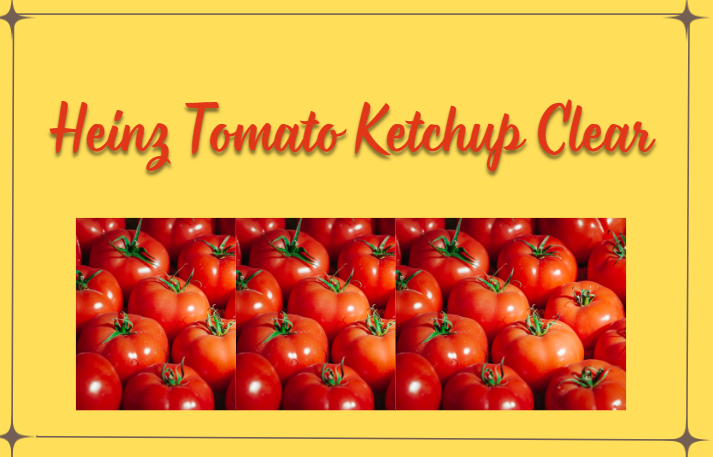Heinz Tomato Ketchup Clear Experiment in Food
Heinz Tomato Ketchup is an iconic condiment, loved worldwide for its rich, tangy flavor. But did you know that Heinz once tried a bold and unexpected twist on their classic product? In the early 2000s, the company launched Heinz Tomato Ketchup Clear, a transparent version of the traditional red ketchup. This unconventional product was part of a wider trend of experimental food innovations at the time, attempting to capture the imagination of consumers, especially children. Let’s dive into the history, concept, reception, and lessons learned from this daring creation.
The Origins of Heinz Tomato Ketchup Clear
In the late 1990s and early 2000s, food companies were racing to introduce novelty products, especially aimed at younger audiences. Colorful, unique, and sometimes bizarre foods were flooding the market. Heinz, as one of the leading ketchup producers in the world, wanted to capitalize on this trend by creating products that broke the mold of what consumers expected.Heinz’s idea for a clear ketchup was a surprising twist. The product was designed to be colorless while retaining the signature taste of Heinz ketchup. It wasn’t just about changing the aesthetics but creating a sensory experience that would intrigue and attract customers. The introduction of Heinz Tomato Ketchup Clear was meant to challenge the norms, offering a ketchup that looked nothing like ketchup but tasted exactly like the real thing.
Read Also : Lower Taper Fade
Production of Heinz Tomato Ketchup Clear
The idea behind Heinz Tomato Ketchup Clear was simple: remove the color without sacrificing flavor. Heinz achieved this by using natural ingredients and removing the tomato pigments, resulting in a transparent condiment that had the same taste as traditional Heinz ketchup. This process did not involve using any artificial coloring or additives to make the ketchup transparent, but instead, Heinz relied on innovative processing techniques to maintain the authentic flavor.
Heinz Tomato Ketchup Clear marketing played
Marketing played a significant role in promoting Heinz Tomato Ketchup Clear. The product was advertised as a fun and playful alternative to regular ketchup, emphasizing its novelty. It was targeted primarily at children and families, who were seen as more open to playful, experimental foods. The marketing highlighted that while the ketchup looked unusual, it tasted just like the beloved original, hoping to convince consumers to give it a try based on curiosity.
Reception and Market Performance
Despite its clever concept and bold marketing, Heinz Tomato Ketchup Clear faced challenges in the marketplace. The clear ketchup certainly intrigued consumers, but it also sparked confusion. For many, ketchup’s red color is synonymous with its identity. A condiment without that familiar color simply didn’t feel right, no matter how similar the taste was.Children, Heinz’s target audience, were initially fascinated by the novelty of the product, but the clear ketchup lacked the visual appeal that bright-colored alternatives, like Heinz EZ Squirt, offered. Heinz EZ Squirt, which came in vibrant colors like green, purple, and blue, was a major success in contrast to the more understated Heinz Tomato Ketchup Clear.
Heinz Tomato Ketchup Clear transparent
Many consumers also found the transparent ketchup unsettling, with some describing it as looking like a gel or jelly, which affected their overall experience of the product. While the flavor might have been on point, the visual and textural differences created a disconnect. Consumers were used to ketchup looking and behaving in a certain way, and Heinz Tomato Ketchup Clear challenged this perception in a way that was difficult for many to accept.
Lessons Learned from Heinz Tomato
The story of Heinz Tomato Ketchup Clear offers several important lessons about consumer preferences, marketing, and innovation in the food industry.Food products, especially those with strong cultural ties like ketchup, often carry deep-rooted associations. Heinz’s attempt to innovate with a clear ketchup clashed with consumers’ entrenched ideas of what ketchup should be. While innovation is essential for staying relevant in the market, tampering with the core identity of a product can lead to consumer resistance.
The Role of Color in Food Perception
Consumers often rely on visual cues to assess the quality and taste of a product before they even taste it. In the case of Heinz Tomato Ketchup Clear, the lack of the familiar red color made the ketchup appear less appetizing, even though the flavor was the same.
Novelty Has Limits
While novelty can drive initial interest, it doesn’t always translate into long-term success. Heinz Tomato Ketchup Clear might have captured attention initially, but it lacked the staying power that comes from consumer demand. Other novelty products, like the brightly colored Heinz EZ Squirt, succeeded because they were playful while still delivering on consumers’ visual expectations for ketchup.
The Legacy of Heinz Tomato Ketchup Clear
Heinz Tomato Ketchup Clear was a bold and creative experiment, but ultimately, it failed to win over the masses. While the product may not have been a lasting success, it highlighted the importance of understanding consumer psychology in food innovation. Color, texture, and tradition all play crucial roles in how consumers perceive and accept new products.Today, Heinz remains a leader in the condiment industry, but the story of Heinz Tomato Ketchup Clear serves as a reminder that not every bold idea works out. However, it also shows that innovation, even when it fails, can provide valuable insights that drive future success.



